A Study on the Water/Polymer Co-Flooding Seepage Law and Reasonable Polymer Injection Volume in Offshore Oilfields
Abstract
:1. Introduction
2. Dynamic Characteristics of the Water/Polymer Co-Flooding
2.1. The Variation Rule of Oil Production and Water-Cut
2.2. Polymer Store Ratio Change Law
3. Study on the Seepage Law of the Water/Polymer Co-Flooding
3.1. The Principle of the Model
3.1.1. Streamline Model
3.1.2. Tracer Model
3.2. Seepage Law Analysis
3.2.1. Experimental Design
3.2.2. Characteristic Analysis of the Streamline Field
3.2.3. Analysis of Tracer Field Characteristics
3.2.4. Quantitative Analysis of the Water/Polymer Interference
3.3. Seepage Law Test
3.3.1. Experimental Design
3.3.2. Seepage Characteristics
3.3.3. Other Seepage Characteristics
4. Analysis of Reasonable Polymer Injection Volume in the Water/Polymer Co-Flooding Stage
5. Conclusions
Author Contributions
Funding
Conflicts of Interest
References
- Du, W. Observations of China’s oil industry in the 13th Five-Year Plan period. Int. Pet. Econ. 2017, 25, 28–32. [Google Scholar]
- Zhu, Y. Current developments and remaining challenges of chemical flooding EOR techniques in China. In Proceedings of the SPE Asia Pacific Enhanced Oil Recovery Conference, Kuala, Lumpur, Malaysia, 11–13 August 2015. [Google Scholar]
- Manrique, E.; Thomas, C.P.; Ravikiran, R.; Izadi, M.; Lantz, M.; Romero, J.L.; Alvarado, V. EOR: Current status and opportunities. In Proceedings of the SPE Improved Oil Recovery Symposium, Tulsa, OK, USA, 24–28 April 2010. [Google Scholar]
- Wang, D.M.; Cheng, J.C.; Wu, J.Z.; Wang, G. Application of polymer flooding technology in Daqing Oilfield. Acta Pet. Sin. 2005, 26, 74–78. [Google Scholar]
- Wu, Y.F.; Mahmoudkhani, A.; Watson, P.; Fenderson, T.R.; Nair, M. Development of new polymers with better performance under conditions of high temperature and high salinity. In Proceedings of the SPE EOR Conference at Oil and Gas West Asia, Muscat, Oman, 16–18 April 2012. [Google Scholar]
- Cleverson, E.; Nima, R.; Amer, A.; Sohrab, Z. Comprehensive review of carbonated water injection for enhanced oil recovery. Fuel 2019, 237, 1086–1107. [Google Scholar]
- Kamal, M.S.; Sultan, A.; Al-Mubaiyedh, U.A.; Hussein, I.A. Review on polymer flooding: Rheology, adsorption, stability, and field applications of various polymer systems. Polym. Rev. 2015, 55, 491–530. [Google Scholar] [CrossRef]
- Schneider, F.N.; Owens, W.W. Steady-state measurements of relative permeability for polymer/oil systems. Soc. Pet. Eng. J. 1982, 22, 79–86. [Google Scholar] [CrossRef]
- Sheng, J.J.; Leonhardt, B.; Azri, N. Status of polymer-flooding technology. J. Can. Pet. Technol. 2015, 54, 116–126. [Google Scholar] [CrossRef]
- Feng, Y.L. Simulation on Polymer Flooding and Water Flooding Working Together in Class II Reservoir. Ph.D. Thesis, Daqing Petroleum College, Daqing, China, 2007. [Google Scholar]
- Zhao, C.S.; Cui, G.Q.; Fu, Z. Numerical simulation study on the optimization of cycle injection and production scheme in middle and high water cut period. Spec. Oil Gas Reserv. 2009, 16, 61–63. [Google Scholar]
- Song, W.L.; Yuan, Y.W.; Liu, Q.J.; Sun, G.; Cui, G. Optimization of the injection parameters in the region of water and polymer flooding together in type II oil reservoir. In Proceedings of the Power & Energy Engineering Conference, Chengdu, China, 28–31 March 2010. [Google Scholar]
- Yan, W.H. Research on Methods of Improving Polymer Flooding Efficiency in Sub-Layers Reservoir of Daqing Oil Field. Ph.D. Thesis, Daqing Petroleum College, Daqing, China, 2008. [Google Scholar]
- Pang, X.H. The Optimization Study on the Water Polymer Flooding Together to Daqing Oilfield Xing Twelve Blocks. Master’s Thesis, Northeast Petroleum University, Daqing, China, 2016. [Google Scholar]
- Xu, Z.S.; Zhang, J.H.; Feng, Z.H.; Fang, W.; Wang, F.L. Characteristics of remaining oil viscosity in water-and polymer-flooding reservoirs in Daqing oilfield. Sci. Sin. 2010, 53, 76–87. [Google Scholar] [CrossRef]
- Yu, X.Y. The Study of Optimizing Injection-Production Designing Method. Master’s Thesis, Northeast Petroleum University, Daqing, China, 2012. [Google Scholar]
- Liu, Y.G. New Progress in Water Injection Control Technology in Bohai Oilfield; Chemical Industry Press: Beijing, China, 2013. [Google Scholar]
- Zendehboudi, S.; Rezaei, N.; Lohi, A. Applications of hybrid models in chemical, petroleum, and energy systems: A systematic review. Appl. Energy 2018, 228, 2539–2566. [Google Scholar] [CrossRef]
- Deng, Y.H.; Li, J.P. Formation Mechanism of Shallow Reservoir: Take Bohai oil Region as an Example; Petroleum Industry Press: Beijing, China, 2008. [Google Scholar]
- Pei, J.Y.; Yang, J.H.; Yang, Y.J.; Hu, J. Designing and optimizing techniques of the injected profile monitoring program in the oilfield development. Pet. Geol. Oilfield Dev. Daqing 2018, 37, 133–137. [Google Scholar]
- Goodarzi, F.; Zendehboudi, S. A comprehensive review on emulsions and emulsion stability in chemical and energy industries. Can. J. Chem. Eng. 2018, 97, 281–309. [Google Scholar] [CrossRef] [Green Version]
- Zhu, Y.; Gao, W.B.; Li, R.S. Action laws and application effect of enhanced oil recovery by adjustable-mobility polymer flooding. Acta Petrol. Sin. 2018, 39, 189–200. [Google Scholar]
- Zhang, R.L.; Yin, X.L.; Winterfeld, P.H.; Wu, Y.S. A fully coupled thermal-hydrological-mechanical-chemical model for CO2 geological sequestration. J. Nat. Gas Sci. Eng. 2016, 28, 280–304. [Google Scholar] [CrossRef] [Green Version]
- Dailami, K.; Nasriani, H.R.; Sajjadi, S.A.; Alizadeh, N. Optimizing oil recovery factor by horizontal and vertical infill drilling using streamline simulation in an Iranian oil reservoir. Energy Sources Part A Recovery Util. Environ. Eff. 2017, 1–8. [Google Scholar] [CrossRef]
- Feng, Q.H.; Li, S.H. Automatic matching for interwell tracer production curve. Petrol. Explor. Dev. 2005, 32, 121–124. [Google Scholar]
- Zhu, K.; Li, J.Y.; Fei, G.Q.; Xie, P.H. Synthesis and oil displacement performance of surface active polymer with long carbon side chain. Spec. Petrochem. 2019, 36, 1–6. [Google Scholar]
- Liu, Y.Y.; Kang, X.D.; Wei, Z.J.; Hao, J.L.; Zhang, J. Permeability contrast of offshore layered unconsolidated sandstone reservoir. Fault-Block Oil Gas Field 2018, 25, 78–81. [Google Scholar]
- Dehdaria, B.; Parsaeia, R.; Riazia, M.; Rezaeib, N.; Zendehboudi, S. New insight into foam stability enhancement mechanism, using polyvinyl alcohol (PVA) and nanoparticles. J. Mol. Liq. 2020. [Google Scholar] [CrossRef]
- Fan, Y.E.; Wang, H.F.; Hu, G.Y.; Song, L.M.; Zhang, J.Y.; Zhang, X.W. Anatomy method of composite sand body architecture in offshore oilfield and its application. China Offshore Oil Gas 2018, 30, 106–116. [Google Scholar]
- Zhang, Y.B.; Lu, X.G.; Wang, T.T.; Liu, Y.G.; Xia, H.; Chen, Y. Study on technology of multi-stage plugging and profile control for advantage channels in Bohai Oilfield. Pet. Geol. Recovery Effic. 2018, 25, 82–88. [Google Scholar]

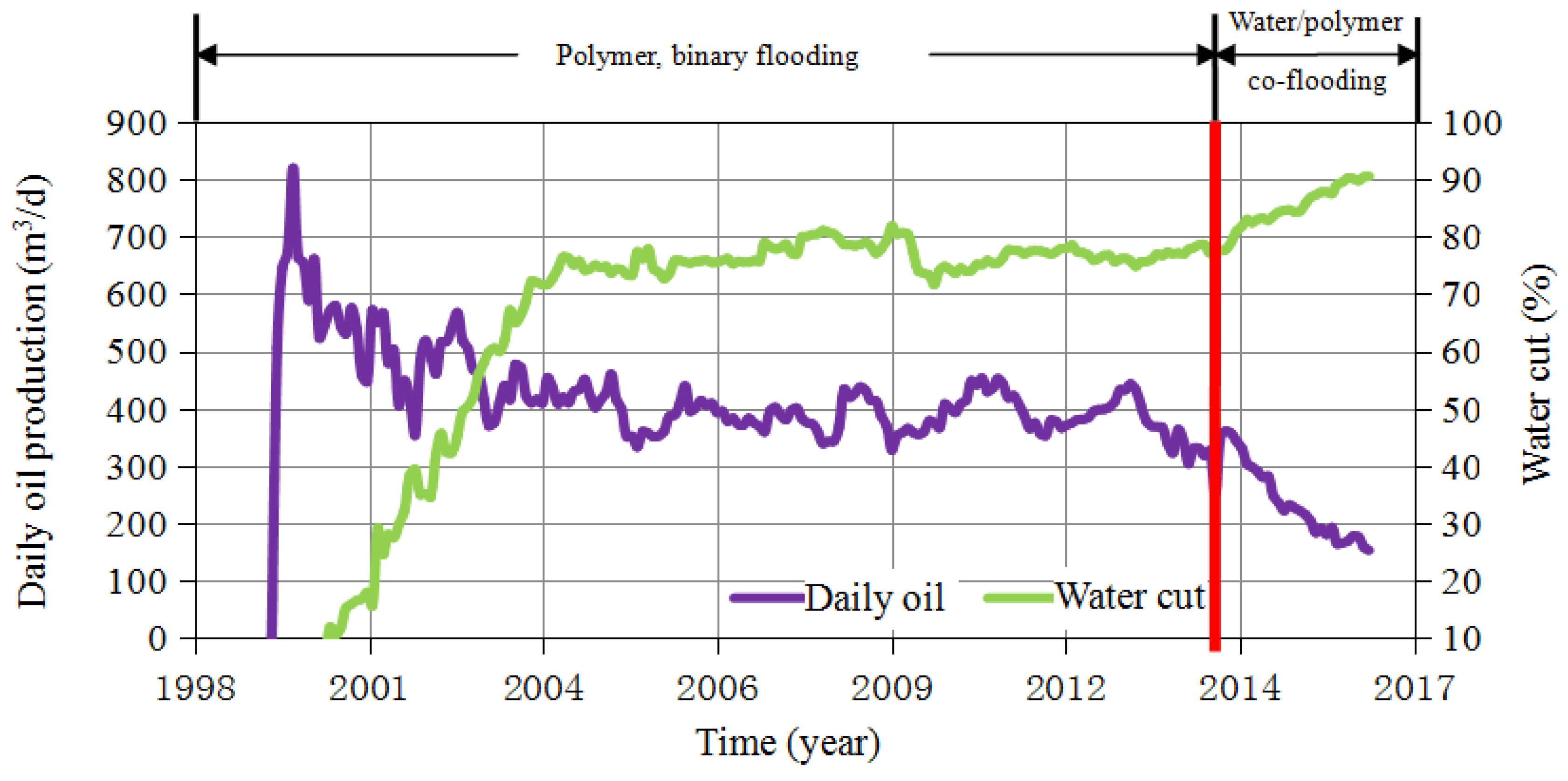


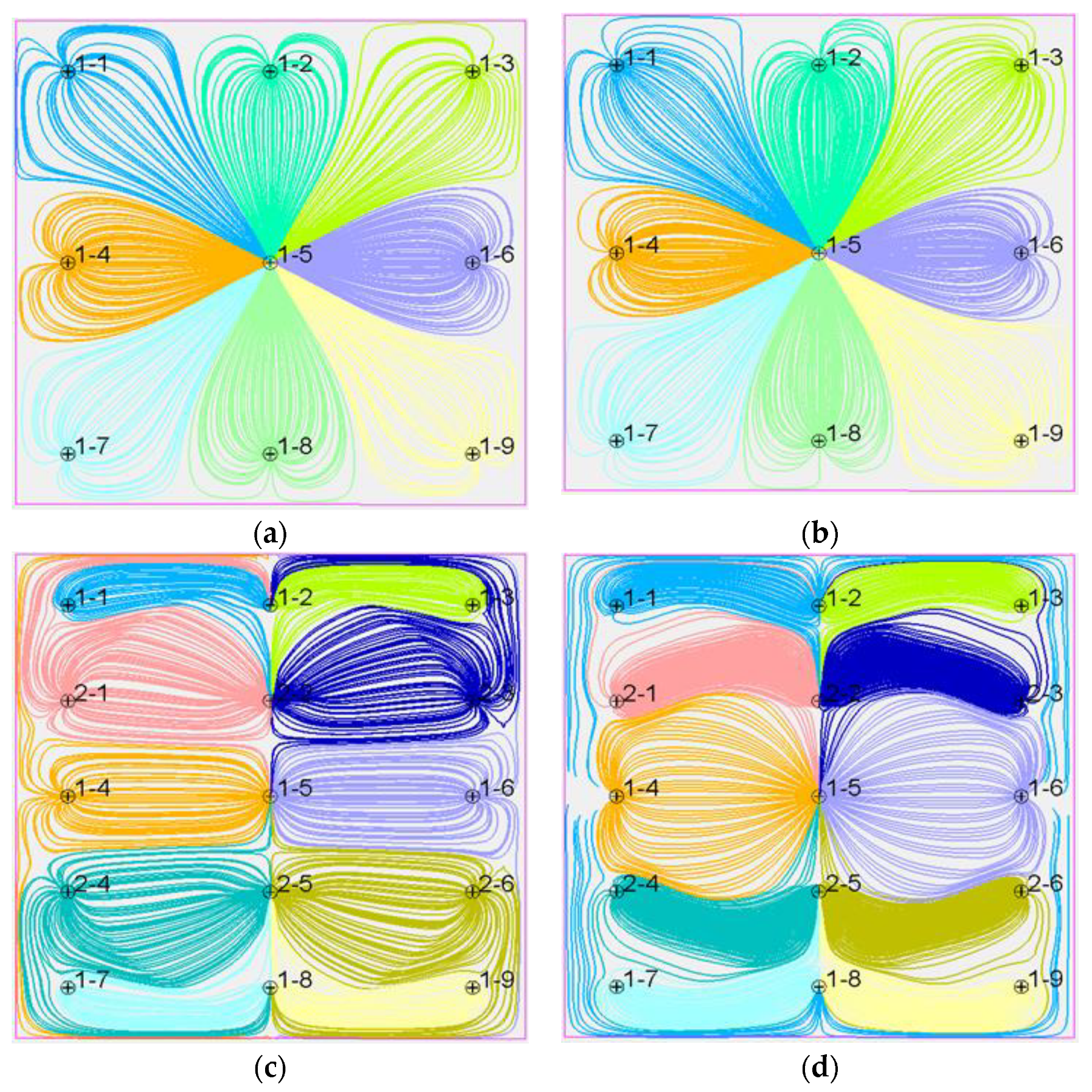

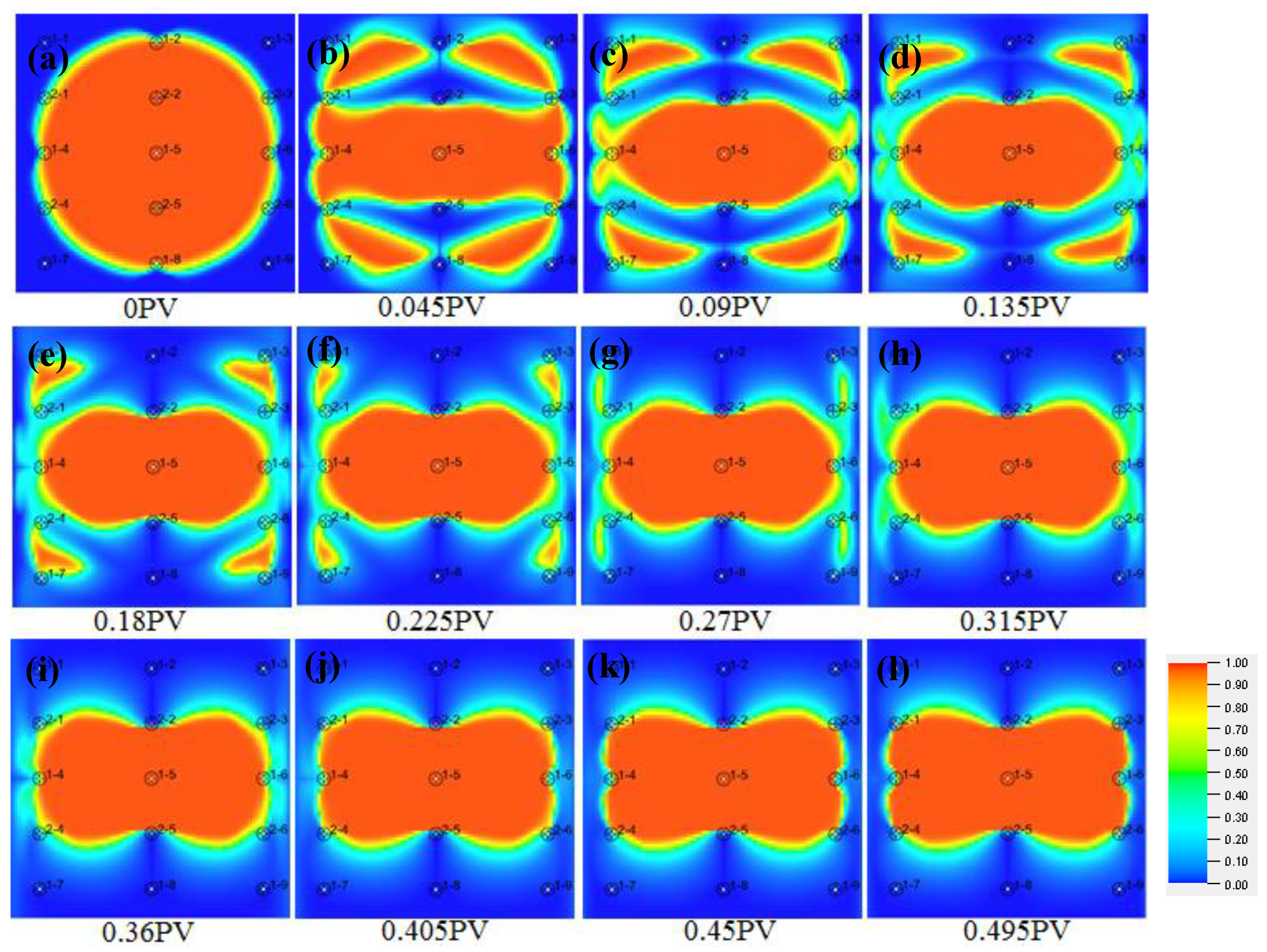

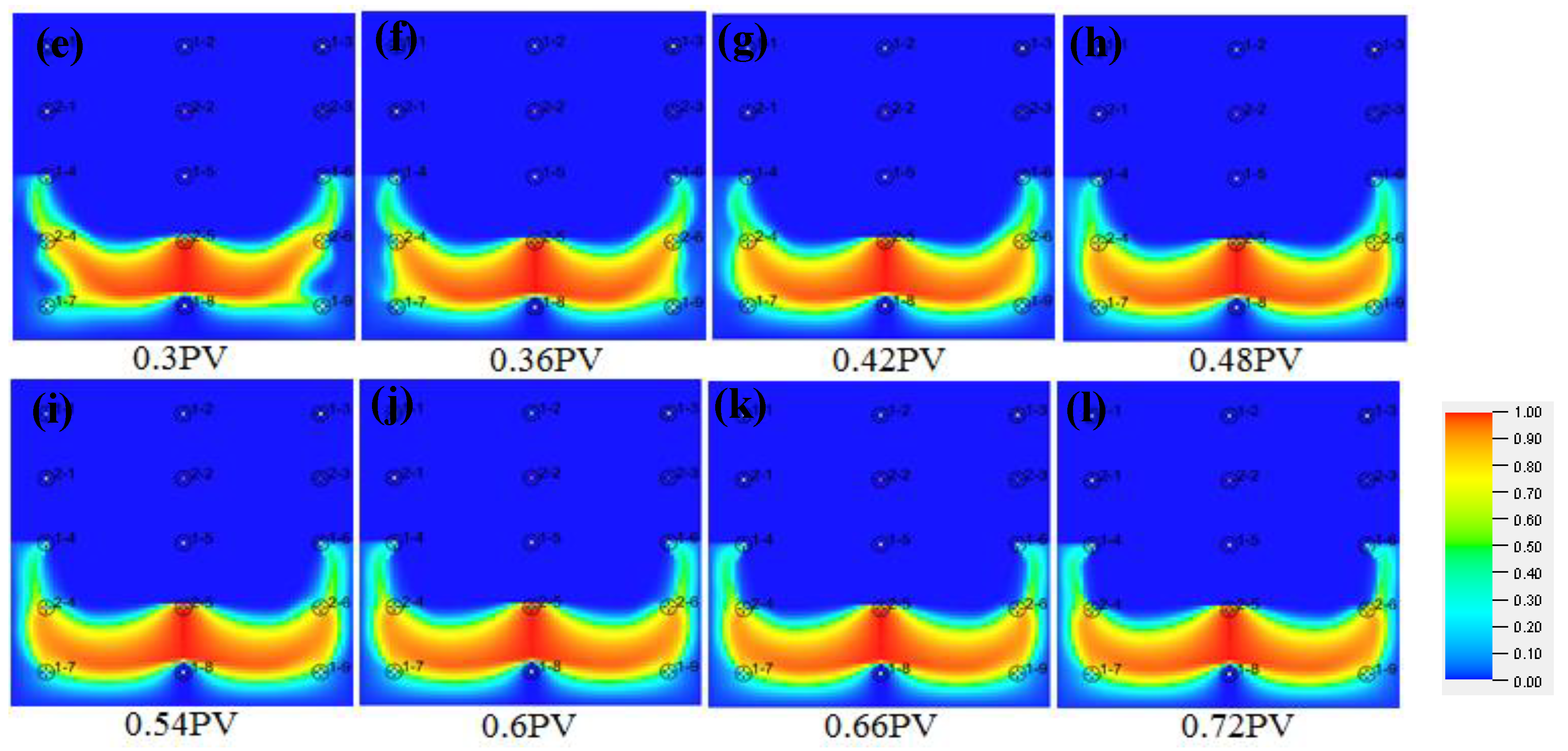

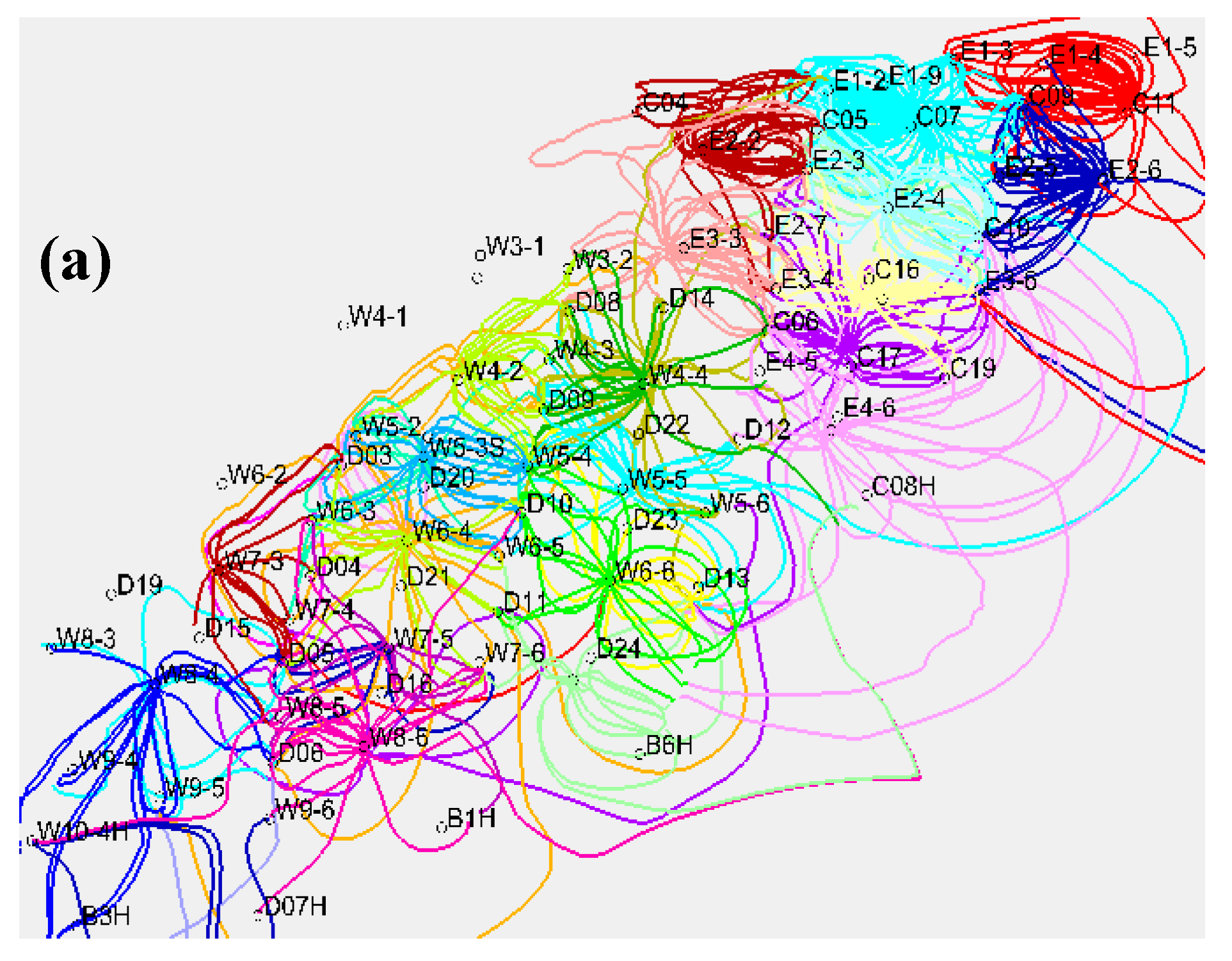


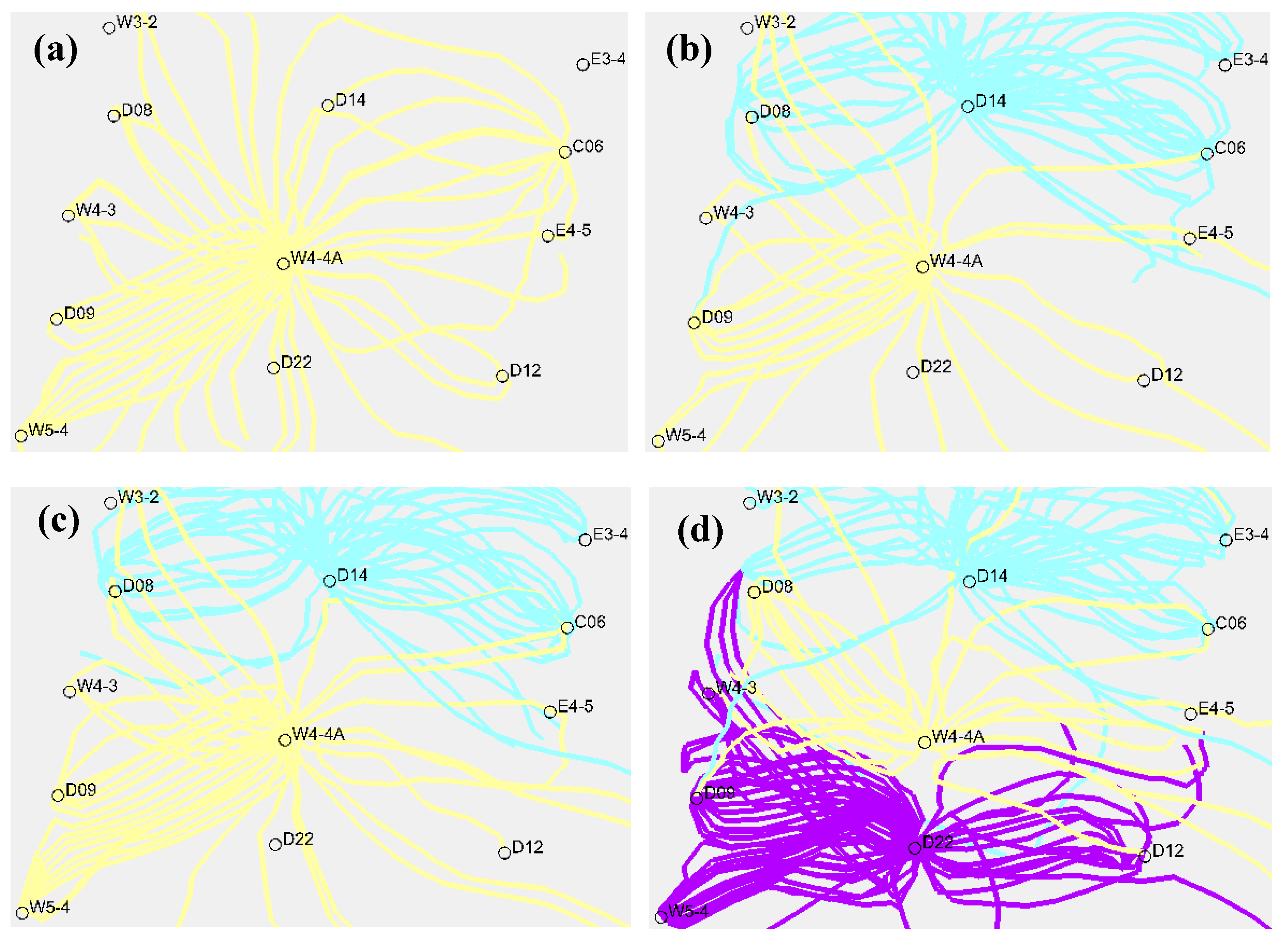
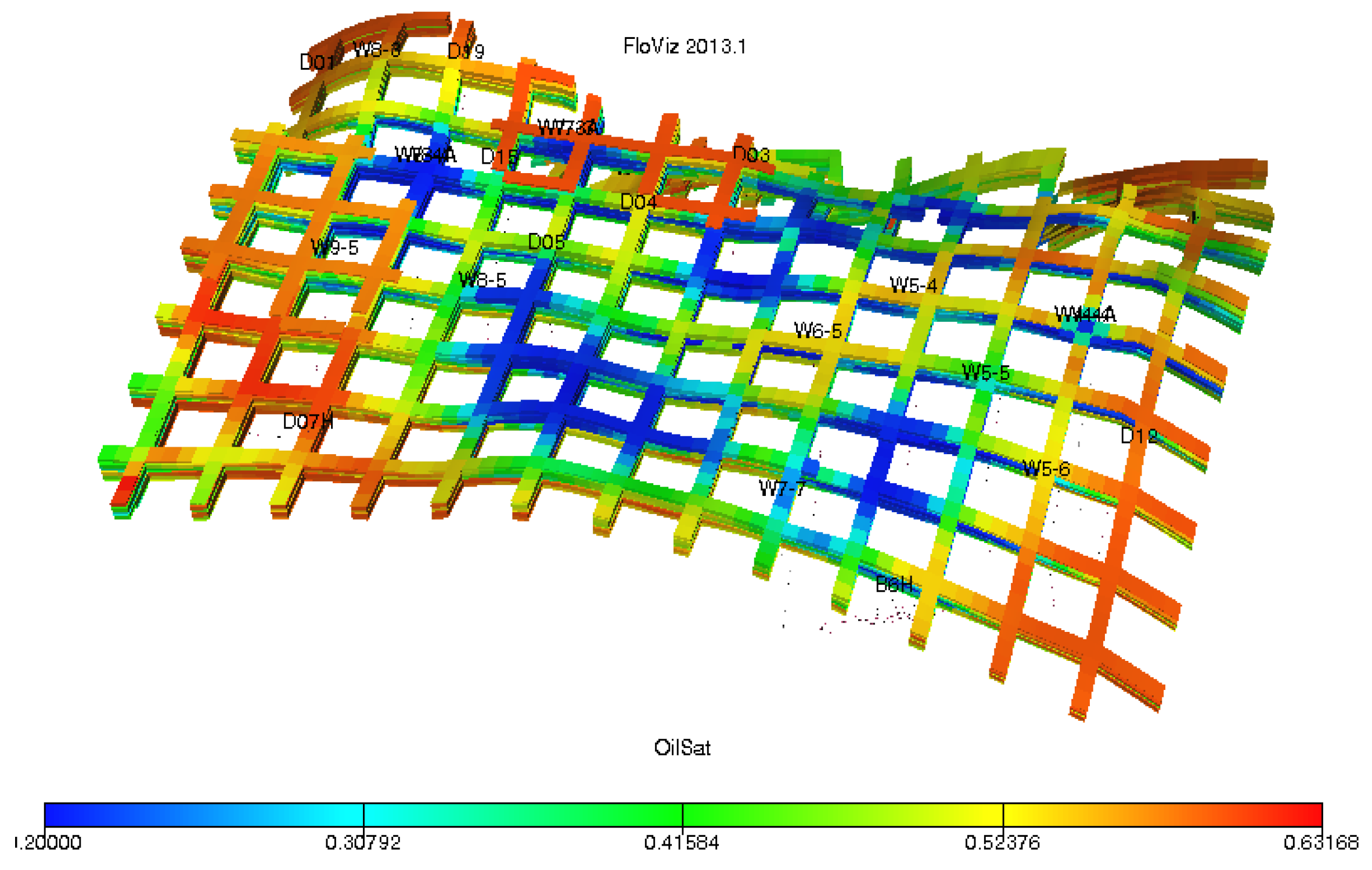
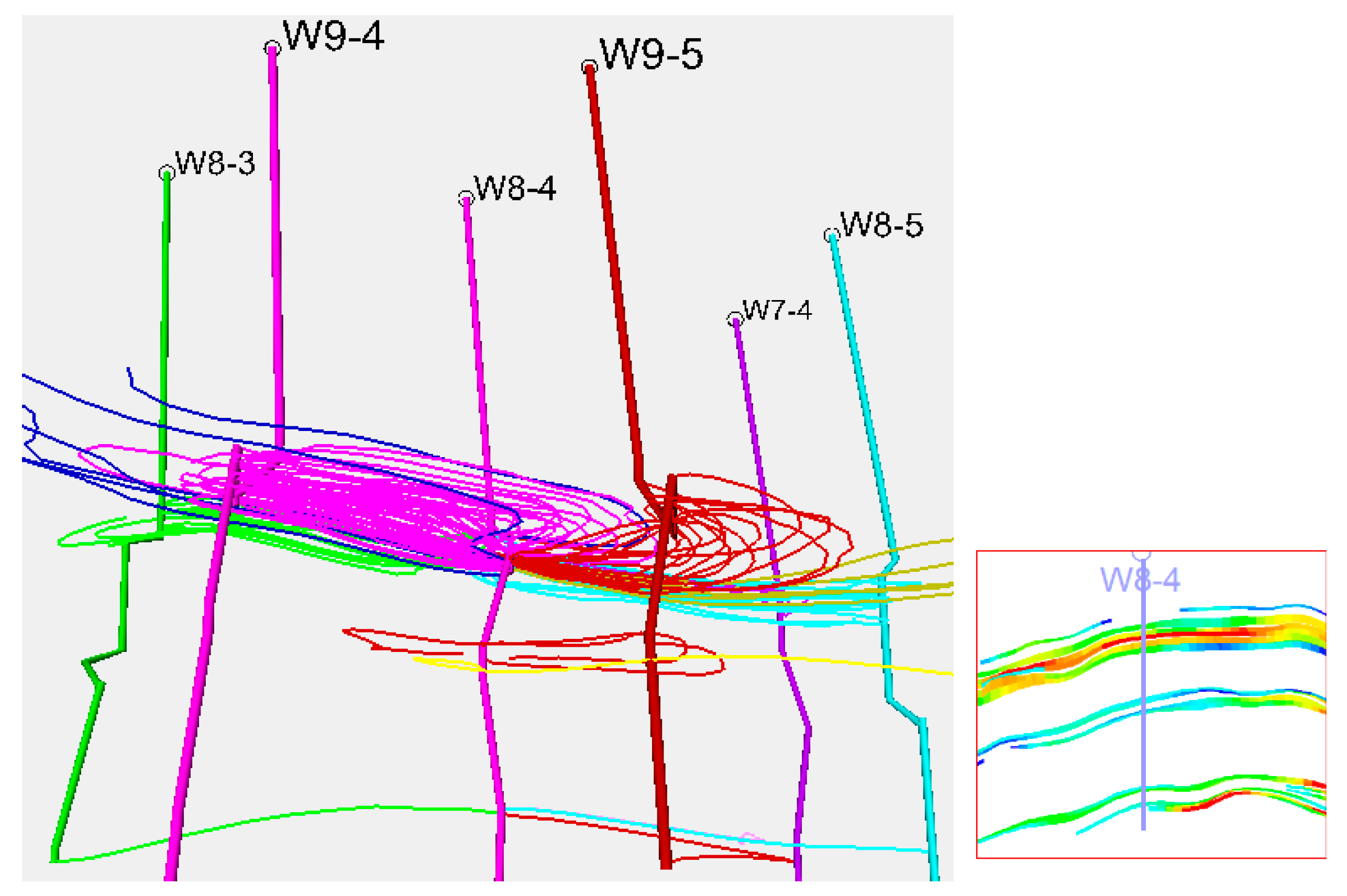
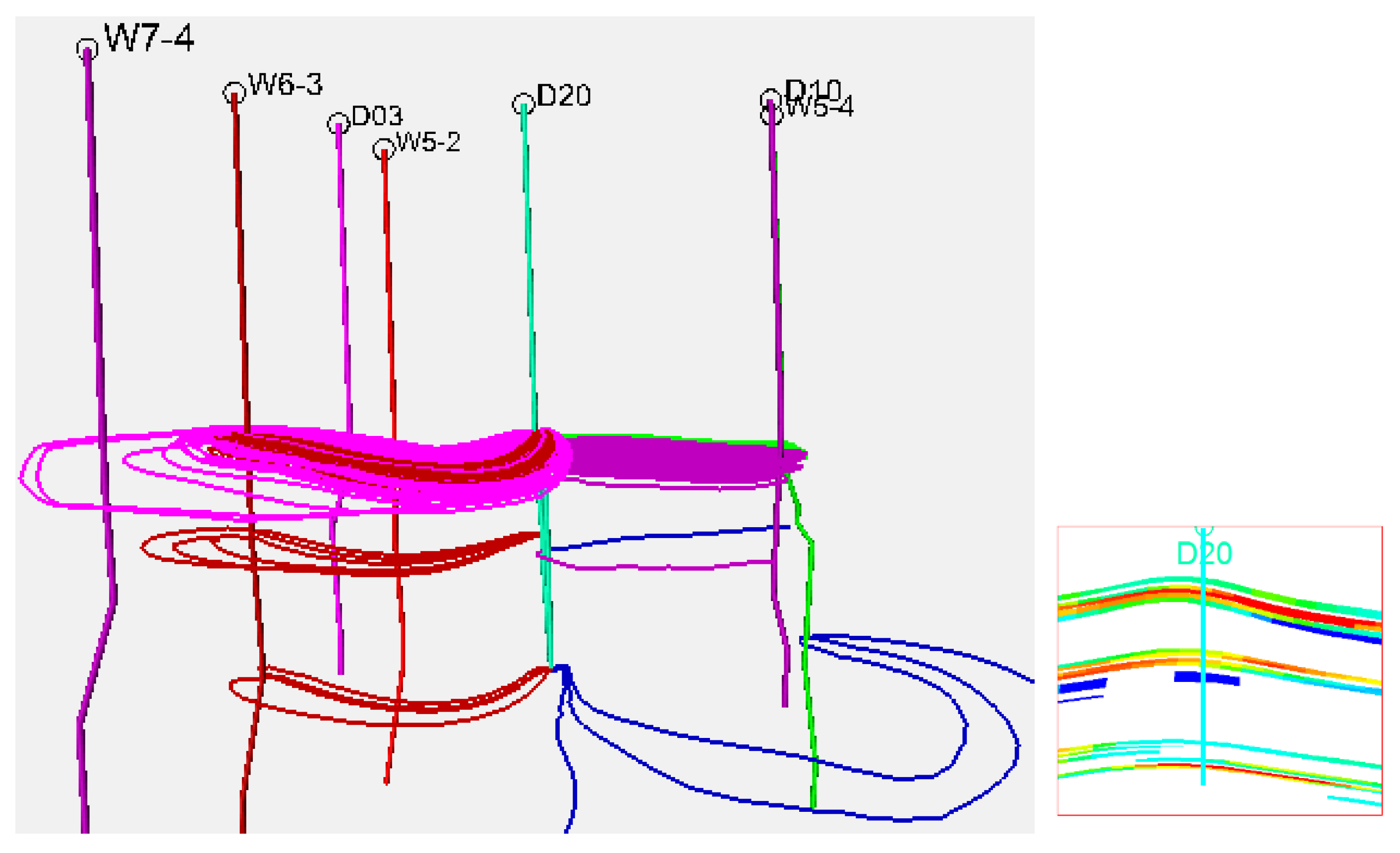
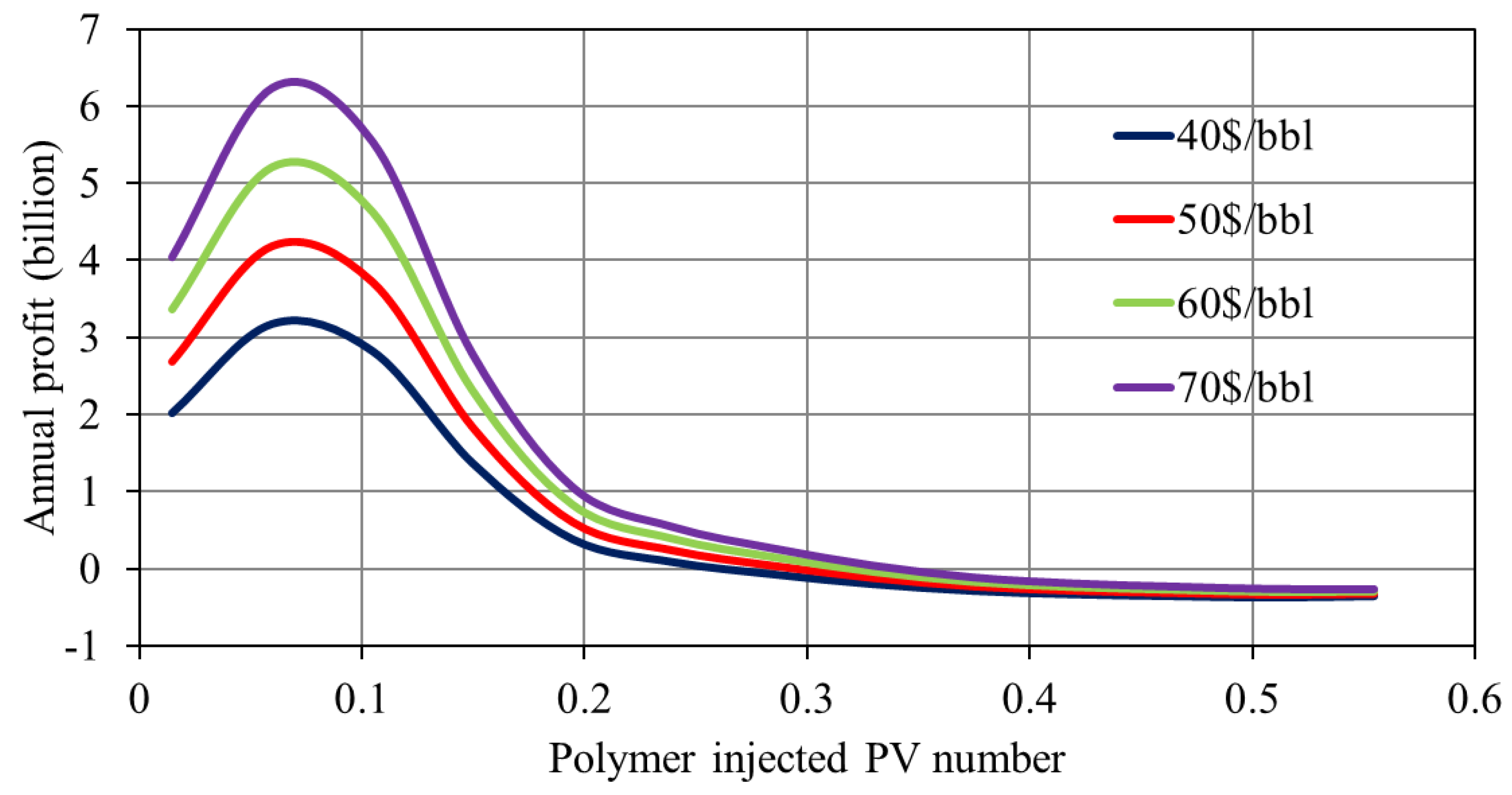

| Name of Oil Field | Depth (m) | Effective Thickness (m) | Porosity (%) | Permeability (10−3 μm2) | Viscosity (mPa s) |
|---|---|---|---|---|---|
| Jinzhou 9-3 | 1580–2000 | 3–40 | 22–36 | 10–5000 | 17.1 |
| Suizhong 36-1 | 1300–1600 | 40–120 | 31–33 | 3123–3594 | 37–155 |
| Lvda 5-2 | 1240–1700 | 15–116 | 30–40 | 100–1001 | 36–210 |
| Lvda 4-2 | 1560–1820 | 4–38 | 24–34 | 50–1000 | 3–4 |
| lvda10-1 | 1330–1666 | 30–60 | 27–35 | 10–5500 | 7–19 |
| Chengbei | 1625–1680 | 15 | 22–36 | 11–9570 | 57 |
| Model | Parameter | Value |
|---|---|---|
| The conceptual fine geological model | The Model area | 0.875 km × 0.875 km = 0.766 km2 |
| The Grid step | 5 m × 5 m × 1 m | |
| The total number of grid | 21.5 × 104 | |
| The phase | oil, water, dissolved gas | |
| The effective thickness | 7 m | |
| The porosity | 0.27 | |
| The permeability | 1162.3 × 103 μm2 | |
| The initial oil saturation | 0.64 | |
| The conceptual numerical model | The grid step | 10 m × 10 m × 1 m |
| The total number of grid | 5.4 × 104 | |
| The initial formation pressure | 17.1 MPa | |
| The oil viscosity | 17.1 mPa s | |
| The water injection rate | 0.045 PV/year | |
| The polymer injection rate | 0.04 PV/year |
| Serial Number | Scheme | Cumulative oil Production after the Well Interspaced (104 m3) | Reduced Proportion | Cumulative Oil Production after the Well Interspaced (104 m3) | Oil Increment of per Ton Polymer (m3/t) |
|---|---|---|---|---|---|
| 1 | Water flooding + polymer flooding + full water flooding after the well interspaced | 10.68 | 3/4 | 11.76 | 35.97 |
| 2 | Water flooding + polymer flooding + full polymer flooding after the well interspaced | 15.01 | 1/4 | ||
| 3 | Water flooding + polymer flooding + water/polymer co-flooding after the well interspaced | 11.42 | 1 | 11.42 | 22.84 |
© 2020 by the authors. Licensee MDPI, Basel, Switzerland. This article is an open access article distributed under the terms and conditions of the Creative Commons Attribution (CC BY) license (http://creativecommons.org/licenses/by/4.0/).
Share and Cite
Wang, J.; Song, L.; Song, K.; Dong, C.; Tian, L.; Chen, G. A Study on the Water/Polymer Co-Flooding Seepage Law and Reasonable Polymer Injection Volume in Offshore Oilfields. Processes 2020, 8, 515. https://doi.org/10.3390/pr8050515
Wang J, Song L, Song K, Dong C, Tian L, Chen G. A Study on the Water/Polymer Co-Flooding Seepage Law and Reasonable Polymer Injection Volume in Offshore Oilfields. Processes. 2020; 8(5):515. https://doi.org/10.3390/pr8050515
Chicago/Turabian StyleWang, Jiwei, Liyang Song, Kaoping Song, Chi Dong, Lingyu Tian, and Gang Chen. 2020. "A Study on the Water/Polymer Co-Flooding Seepage Law and Reasonable Polymer Injection Volume in Offshore Oilfields" Processes 8, no. 5: 515. https://doi.org/10.3390/pr8050515




